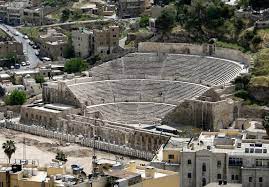Unit 6
Lesson 7
Language development
SB page 75 / exercise 1:
*To remind you

1 Complete this dialogue with the correct form of the verbs in brackets.
|
Zeina: Hi Nadia! How are you? Nadia: Zeina? Where are you? I thought you were in Disneyland with Malek and the children. Zeina: That’s precisely where I am! We _________(1) (have) a great time. Zeina: It’s fantastic! Now I can understand why it is the most popular amusement park in the world. Nadia: Are Malek and the boys enjoying it there? Zeina: Yes, they are. Malek ____________(2) (fish) right now. Sami ________(3) (play) golf, and Tareq (4)__________ (ski). Nadia: And what __________(5) you and the girls (do)? Zeina: I_______ (6) (relax) on the beach and the girls (7)_______ (play) at the Neverland Club. |
The answer:1. are having; 2. is fi shing; 3. is playing; 4. is skiing; 5. are/doing; 6. am relaxing; 7. are playing
********************************************
SB page75 / exercise 2:
2 Use these words to ask questions about the above dialogue.
1. family / Zeina / her / ? / are / Where / and
_____________________________________________________
2. are / boys / ? / the / What / doing
____________________________________________________
3. on / relaxing / Zeina / beach / ? / Is / the
____________________________________________________
4. the / doing / ? / are / What / girls
____________________________________________________
The answer:
1. Where are Zeina and her family?
2. What are the boys doing?
3. Is Zeina relaxing on the beach?
4. What are the girls doing?
***********************************************
SB page 75 / exercise 3:
3 Now in pairs, answer them.
Answers 1. They are in Disneyland. 2. Sami is playing golf and Tareq is skiing. 3. Yes, she is. 4. They are playing at the Neverland Club.
***************************************************
SB page 75 exercise 4:
4 In pairs, write the names of different places on pieces of paper—use the list below to guide you. Then you and your partner take turns to choose a piece of paper, and ask and answer questions to fi nd out where you are.
| theatre/ café/ market/ museum /school /swimming pool/ train station/ living room /beach |
Example:
|
A: Are you reading? B: No, I’m not. A: Are you buying books? B: Yes, I am. A: You are at a bookshop! B: Yes, I am |
The answer: Students’ own answers
**************************************************
SB page 75 exercise 5:
5 Imagine you are on holiday in New Zealand. Write fi ve sentences about what you and the members of your family are doing. In pairs, ask and answer questions
Example:
| A: What’s your father doing? B: He’s playing football. |
Answers may include:
• tourist spots
• sunbathing
• swimming
• touring
• trying local dishes
***********************************
SB page 76 / exercise 6:
6 Put the following words under the three headings in the table below

The answer:
| Types of holiday | People | Actions |
|
ecotourism adventure holiday beach holiday |
traveller scholar historian sailor |
sunbathe lie relax |
*********************************************************
Unit 6
Lesson 8
Project 6
| To practise the language in a cooperative and non-stressful atmosphere |
| Your task is ... To make a tourist brochure about a place Ibn Battuta visited, and tell the class about it. |
|
This is Malaga today. Six hundred years ago, when Ibn Battuta visited it, he said: “Malaga is smaller than Granada. But it is one of the largest and most beautiful towns of Andalusia.” |
|
This is the Alcazaba. Badis, ruler of Malaga, built it in 1057 CE. This fortress is one of the largest Muslim military buildings in Spain. Don’t miss the view over the town and the port |
|
Finally, visit the Roman Theatre. It is right next to the Alcazaba. |
• To prepare for this project, you have to do some individual research about a place Ibn Battuta visited. you have to identify the purpose of the brochure and the audience.
collect examples of tourist brochures from museums, hotels, a tourist information office, or look for examples on the Internet or in newspapers and magazines.


